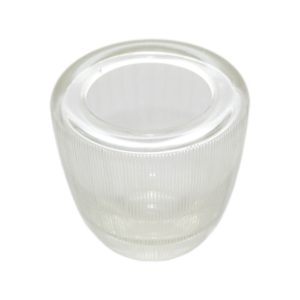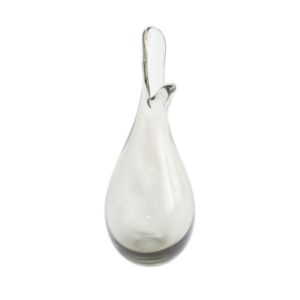- You cannot add "Green bullicante Murano ashtray" to the cart because the product is out of stock.
Tricolor Murano ashtray (or dish) in blue, red and green
45 €
Tricolor Murano ashtray (or dish) in blue, red and green. This piece is remarkable in its fluid shapes, the zoomorphic look (seen from the top, it resembles the image of a cat’s head), the fine quality of the glass, and the dialogue between the three differently colored compartments. Hand blown, this piece is kept in very good vintage condition.
The quality and tradition that characterize Murano’s finest glass furnaces have always been worthy of the highest appreciation. This prestige is due mostly to the glass masters’ hard work and dedication, which are the very core of Murano’s most famous trade. Glassmaking has been passed on from one generation to the next one, with constant innovations and timeless originality. The loyalty and respect with which this trade is treated is possibly the key to Murano’s success. Glass masters all over the island have always worked with endless vitality, and this creative vein is evident in every glass artwork that comes out of any furnace, with improved techniques and bewildering effects.
Source: glassofvenice.com
Out of stock
You may also like
-
Sold out

Spectacular Murano cigar ashtray from the 1960s
Sold ItemsSpectacular Murano cigar ashtray made of glass. The piece is distinguished by its fluid shapes, by the fine quality of the glass, as well as by its intense and extremely beautiful ruby red color. Hand blown, this piece is kept in very good vintage condition. The quality and tradition that characterize Murano’s finest glass furnaces have always been worthy of the highest appreciation. This prestige is due mostly to the glass masters’ hard work and dedication, which are the very core of Murano’s most famous trade. Glassmaking has been passed on from one generation to the next one, with constant innovations and timeless originality. The loyalty and respect with which this trade is treated is possibly the key to Murano’s success. Glass masters all over the island have always worked with endless vitality, and this creative vein is evident in every glass artwork that comes out of any furnace, with improved techniques and bewildering effects. Source: glassofvenice.com45 € -

Controlled bubbles (bullicante) Murano ashtray
Glass & Ceramics, Home AccessoriesBeautiful controlled bubbles (bullicante) Murano ashtray made of glass. Hand blown, this piece displays a nice chromatic effect and goes from dark green (to the rim) to clear white (at the bottom). The quality and tradition that characterize Murano’s finest glass furnaces have always been worthy of the highest appreciation. This prestige is due mostly to the glass masters’ hard work and dedication, which are the very core of Murano’s most famous trade. Glassmaking has been passed on from one generation to the next one, with constant innovations and timeless originality. The loyalty and respect with which this trade is treated is possibly the key to Murano’s success. Glass masters all over the island have always worked with endless vitality, and this creative vein is evident in every glass artwork that comes out of any furnace, with improved techniques and bewildering effects. The “bullicante” effect is amongst the most famous glass making techniques and it is seen quite often around the island of Murano. If you’ve had the fortune of strolling along the streets of Venice, you would have noticed beautiful glass pieces with small air bubbles trapped in the inside, possibly stopping to wonder how that seemingly impossible effect is achieved. This peculiar effect is obtained by placing a piece of molten glass inside a metallic mold with spikes, very much resembling a pineapple’s texture. These spikes cause small holes on the surface creating a pattern all around the glass piece. After it’s been left to cool down for a few moments, the whole piece is submerged in molten glass again. This second layer completely covers the first one. However, thanks to the thick consistency of glass, the holes previously impressed on the first layer are not covered, thus causing air to be trapped between both layers of glass. This process can be repeated several times, creating a pattern as complicated as the glass master wishes. This technique gives not only a sense of depth to the whole object, but also an incomparable decorative effect, famous for its originality. Source: glassofvenice.com40 €
Additional information
| Maker | |
|---|---|
| Design Period | 1960-1969 |
| Country of Origin | |
| Restoration, Damages | Minor wear consistent with age and use |
| Material(s) | |
| Color(s) | |
| Weight | 1050 g |
| Dimensions (H x W x D) | 6 x 15 x 15 cm |
| Duties Notice | If your delivery address is not in the European Union, Iceland, Liechtenstein, Norway, or Switzerland, please be advised that import duty is not included in the prices you see online |
Product Enquiry
About Mid-Century
The quality and tradition that characterize Murano’s finest glass furnaces have always been worthy of the highest appreciation. This prestige is due mostly to the glass masters’ hard work and dedication, which are the very core of Murano’s most famous trade. Glassmaking has been passed on from one generation to the next one, with constant innovations and timeless originality. The loyalty and respect with which this trade is treated is possibly the key to Murano’s success. Glass masters all over the island have always worked with endless vitality, and this creative vein is evident in every glass artwork that comes out of any furnace, with improved techniques and bewildering effects.
Murano’s reputation as a center for glassmaking was born when the Venetian Republic, fearing fire and the destruction of the city’s mostly wooden buildings, ordered glassmakers to move their foundries to the island in 1291. Murano glass is still associated with Venetian glass.
Murano’s glassmakers were soon numbered among the island’s most prominent citizens. By the fourteenth century, glassmakers were allowed to wear swords, enjoyed immunity from prosecution by the Venetian state and found their daughters married into Venice’s most affluent families. While benefiting from certain statutory privileges, glassmakers were forbidden to leave the Republic. However, many of them took the risks associated with migration and established glass furnaces in surrounding cities and farther afield — sometimes in England and the Netherlands.
Murano’s glassmakers held a monopoly on high-quality glassmaking for centuries, developing or refining many technologies including optically clear glass, enameled glass (smalto), glass with threads of gold (aventurine), multicolored glass (millefiori), milk glass (lattimo), and imitation gemstones made of glass. Today, the artisans still employ these centuries-old techniques, crafting everything from contemporary art glass and glass jewelry to Murano glass chandeliers and wine stoppers.
Venice kept protecting the secret of the production of glass and of crystal but, notwithstanding it, the Republic partially lost its monopoly at the end of the sixteenth century, because of some glass makers who let the secret be known in many European countries.
Today, Murano is home to the Museo del Vetro in the Palazzo Giustinian, which holds displays on the history of glassmaking as well as glass samples ranging from Egyptian times through the present day.
Some of the companies that own historical glass factories in Murano are among the most important brands of glass in the world. These companies include Venini, Alessandro Mandruzzato Ferro Murano, Barovier & Toso, Simone Cenedese and Seguso. In order to protect the original Murano Glass art from foreign markets, the most famous Glass Factories of this island have a trademark that certifies glass made products on the island of Murano.
The oldest Murano glass factory that is still active today is that of Pauly & C. – Compagnia Venezia Murano, founded in 1866.












